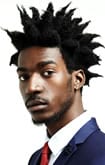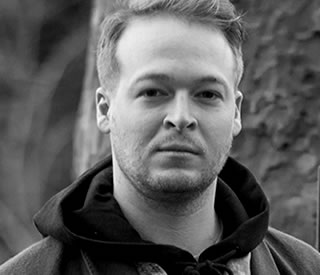The story always plays out the same. You look at the runway pictures and think, yeah, maybe. Those slim-fit jeans have been feeling a bit restrictive recently. And didn’t your boss turn up at work in spray-on jeans the other week? You spot what appeared at fashion week on some street style don. Then an Instagram influencer. A glossy editorial.
When it hits shelves nine months on you’ve already decided yes, this one’s for you. You buy, try, and feel awkward when friends comment on its debut. Then in creeps comfort – body and brain acclimatise to a new shape. What was a statement becomes default. Facebook proffers a skinny-jeaned time capsule and you shudder. This shape, this is the one that actually flatters a man’s body.
Time ticks on and your wardrobe expands until, one day, you try something new. Saw it in an ad, thought why not? It feels… OK. OK becomes everyday. Eventually, wide legs get muscled out. Facebook. Shudder. This is the shape. Repeat.
“A fashion trend lasts two to five years,” says Henrik Vejlgaard, a trend forecaster whose book, Anatomy Of A Trend, analyses how these cycles bubble from idea to ubiquity, then eventually burst. However immune you think you are, however static your style, at some point trends will infiltrate your world.
 Runway trends have a habit of infiltrating your wardrobe, no matter how timeless your styleDolce & Gabbana SS16
Runway trends have a habit of infiltrating your wardrobe, no matter how timeless your styleDolce & Gabbana SS16They move from insiders down the fashion food chain, percolating through society until what was once cutting edge becomes the norm. Each group endorses the trend for the group behind, but taints it for the ones before. You see Zayn’s souvenir jacket, you want it. Your dad takes a shine to yours, you take it to Oxfam.
But there’s a distinction, Vejlgaard says, between a trend and a fad. Fads burn bright, then fade away, a six-month burst of colour, or a pattern that appears for a season then goes back in the drawer. Womenswear tends towards the former, says Graeme Moran, head of fashion and features at industry bible Drapers: “One season will be all black and white, the next everything’s colour. But menswear changes slowly. It’s more gradual.”
Which is why, when these shifts do occur, they can seem titanic. For a decade, we’ve dressed slim, as Hedi Slimane’s skinny-obsessed Dior tenure met Don Draper’s suits and a generation of men suddenly discovered how clothes could really, really fit. But as the trend filtered down, what seemed transgressive on runways became the norm.
 For better or worse, Don Draper influenced how a generation of men dressed for work
For better or worse, Don Draper influenced how a generation of men dressed for workApprentice candidates, fashion’s canaries, popped up in narrow lapels and cropped trousers. Dads no longer saw their sons’ skinny jeans as effeminate, but as a viable option. In reaction, silhouettes expanded. Tailoring lost its padding. After a decade, trussed up menswear seemed to – aaaah – relax.
The pattern is so predictable; it can seem like the customer isn’t even involved. When runway season sees variations on such narrow themes – a ubiquitous fabric, an omnipresent cut – you end up wondering if they’re all in some collusive WhatsApp group. “Hey Raf, let’s do big trousers this year, yeah? lol Demna.”
The reality is less sinister, if no less opaque. Your wardrobe is predicted two years ahead of time. But it’s done by Powerpoint, not text. And though forecasters don’t dictate what you’ll wear, they do at least steer with a heavy hand. Because fashion is business – a leviathan, $3bn global business – and money loves certainty.
The further down the runway brands can see, the less chance they’ll show skintight tailoring when customers want something that billows. Which lessens the chance an entire season ends up on markdown.
 Relaxed cut menswear has been years in the making and is a direct response to our propensity for skinny and slim fits
Relaxed cut menswear has been years in the making and is a direct response to our propensity for skinny and slim fitsOne of the most important hands on fashion’s tiller belongs to Volker Kettennis, a former designer, now menswear director at
WGSN. Since its founding in 1997, the company has sifted cultural flotsam to pinpoint how designers translate what they see in the world to their runways, and whether those designs might percolate down to the masses.
Just as importantly, WGSN lets designers approach a new season with some context. Fashion is a tension between the new and the familiar: tip too far one way and you’re boring; the other, customers get spooked. Trend forecasters show designers what consumers want, so they can flex their creative muscle in ways that will still sell. “Being completely in a vacuum is not always sensible,” says Kettennis. “You need to be aware of the space you operate in. The things going on around you. Then you can decide to go with them or against.”
Which means that what hits runways isn’t the output of a single, creative mind, but grounded in research about where tastes are now, and where they’re heading. This process is geared around fashion’s production cycle: from first designs to runway show takes up to a year, then another before the clothes hit stores.
So while brands work on SS16, Kettennis’ team pulls together predictions for SS18. They pore over developments in fabrics and manufacturing, but also what’s happening in film, art, design, sport, politics – “The things that directly influence fashion,” he says, “but also the things that influence designers.”
 WGSN predicts what we’ll want to wear two years ahead, based on what’s happening in film, art, design, sport and politics
WGSN predicts what we’ll want to wear two years ahead, based on what’s happening in film, art, design, sport and politicsWhich is why, despite designers working apart, common threads emerge. “Exhibitions are hugely important,” says Carol Morgan, a lecturer in fashion communication at Central Saint Martins. Two years on from the V&A’s record-breaking David Bowie retrospective, menswear was awash in the thin white duke’s androgynous shapes and lush fabrics. Morgan predicts that this year’s celebration of punk’s 40th anniversary will also emerge on runways. Which means now’s a good time to get those tartan trousers out of storage.
The move towards a new silhouette also has pragmatic roots. The boom in sneaker culture drove trouser hems upwards, the better to flash those new Jordans. “That [also] affects leg width,” says Kettennis; when they don’t break on your shoe, wider trousers have more weight, so they hang better.
Throw in a resurgent skate culture, a reappreciation of 1990s style, and menswear’s general move more casual, and suddenly it seems like wide legs arrived overnight. But what it really means is that they’re sticking around. At least, until your dad catches on.
 Runway trends have a habit of infiltrating your wardrobe, no matter how timeless your styleDolce & Gabbana SS16
Runway trends have a habit of infiltrating your wardrobe, no matter how timeless your styleDolce & Gabbana SS16 For better or worse, Don Draper influenced how a generation of men dressed for work
For better or worse, Don Draper influenced how a generation of men dressed for work Relaxed cut menswear has been years in the making and is a direct response to our propensity for skinny and slim fits
Relaxed cut menswear has been years in the making and is a direct response to our propensity for skinny and slim fits WGSN predicts what we’ll want to wear two years ahead, based on what’s happening in film, art, design, sport and politics
WGSN predicts what we’ll want to wear two years ahead, based on what’s happening in film, art, design, sport and politics







